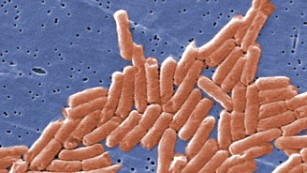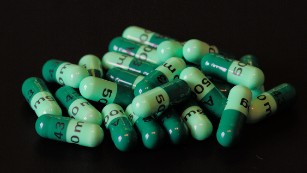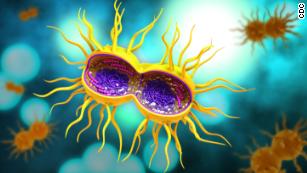
A drug-resistant “superbug” that doctors have been dreading has shown up in the U.S. for the first time, researchers reported Thursday.
The bacteria has genetic changes that make it resistant to a last-ditch antibiotic called colistin and while it had been seen in Europe and China, no one in the U.S. had been seen with it before.
A team at the Walter Reed Army Institute for Research identified a strain of E coli from a Pennsylvania woman that carries a much-feared gene called mcr-1 that turns bacteria into “superbugs. Here, a lab worker tests some of the sample.Walter Reed Army Institute of Research
It doesn’t spell doom just yet.
The mutant E. coli germ was found in a Pennsylvania woman with symptoms of a urinary tract infection, but it does not appear to be spreading at epidemic proportions. And it was susceptible to other antibiotics, so the patient was not left without any hope.
What’s worrying is the gene that made the E. coli drug-resistant. It’s called mcr-1, and it is passed from one bacteria to another. It sits on a piece of material called a plasmid, which makes it easy for one species of bacteria to pass it along to another species of bacteria.
Scientist fear an E. coli bacteria with the mcr-1 gene could pass it to another superbug with other mutations– creating a truly super-superbug that resists all known antibiotics.
“It is the end of the road for antibiotics unless we act urgently.”
“It is the end of the road for antibiotics unless we act urgently.”
If such a superbug spread, it would take the world back to a time when there were no antibiotics, says Dr. Tom Frieden, director of the Centers for Disease Control and Prevention.
“It is the end of the road for antibiotics unless we act urgently,” he said.
This discovery suggests the drug-resistance gene has been here in the U.S., flying under the radar.
“This patient hadn’t traveled,” Frieden said.
Patrick McGann and colleagues at the Walter Reed Army Institute of Research just outside Washington D.C. have been looking at samples from patients, keeping an eye out for bacteria with the mutation.
They reported Thursday they found one. The sample is E. coli bacteria with mcr-1.
“I was extremely surprised when it came up positive,” McGann told NBC News. It was the very first sample his lab tested in the new search for the gene.
This little stretch of DNA, which bacteria can swap easily among themselves, gives them the ability to fight off the effects of colistin.
“It was an old antibiotic, but it was the only one left for what I called nightmare bacteria, carbapenem-resistant enterobacteriaceae, or CRE,” Frieden said.
Luckily, this particular bacteria was not also resistant to carbapenems. But it was resistant to several other classes of antibiotics, including fluoroquinolones, and the fact that it had the mcr-1 gene raises alarm bells.
“To the best of our knowledge, this is the first report of mcr-1 in the USA,” the Walter Reed researchers wrote in their report, published in the journal Antimicrobial Agents and Chemotherapy.
They’ve only been looking for this particular mutation for three weeks, so they said they’re not sure just how widespread it is.
“We know now that the more we look, the more we are going to find,” Frieden said in a speech at the National Press Club in Washington. “The more we look at drug resistance, the more concerned we become.”
Later Thursday, the health and Human Services Department said scientists had also found the mcr-1 mutation in a sample from a pig. “Out of 949 animal samples screened so far, one strain of colistin-resistant E. coli was found in a pig intestinal sample,” it said in a statement.
“The DNA sequence of this isolate revealed that the strain contained the mcr-1 gene on a plasmid. The scientists also determined that the mcr-1 carrying colistin-resistantE. coli is resistant to other antibiotics including ampicillin, streptomycin, sulfisoxazole, and tetracycline.”
CDC has been warning for years about the threat of drug-resistant bacteria. It’s been urging drug companies to develop new antibiotics, and asking people to make better use of the antibiotics now available so that more superbugs do not evolve.
“The medicine cabinet is empty for some patients,” Frieden said.
The CDC said it was working with the state health department in Pennsylvania to talk to the patient and her family to see how she may have been infected.
“We know now that the more we look, the more we are going to find.”
“We know now that the more we look, the more we are going to find.”
They’ll also test others in the area who may have been in contact to see if they are carrying the bacteria – which may not necessarily cause illness or any symptoms at all.
“An urgent public health response is underway to contain and prevent potential spread of mcr-1,” Walter Reed said in a statement.
Dr. David Hyun of the Pew Charitable Trusts, who follows the issue of drug-resistant bacteria, said details will be important. “I am very interested in finding out how did this patient do,” he told NBC News. “What kind of treatment did she receive?”
There have been reports in other countries of patients with bacteria carrying mcr-1, but not many details of how they were cared for or whether other antibiotics cured their infections.
Colistin, used to treat carbapenem-resistant Enterobacteriaceae or CRE, is an older antibiotic with some tough side-effects such as kidney damage. That’s why it’s only used as a last resort.
Hyun said in several of the international cases, people have been infected with CRE that carried the mcr-1 gene. That would leave them with few, if any, option for treatment. “If we are finding it in other countries, chances are that it’s already happened in the United States as well,” he said.
Bacteria develop resistance to drugs quickly. Even before penicillin was introduced in 1943, staphylococcus germs had genes that would have made them resistant to its effects.
Just nine years after tetracycline was introduced in 1950, a resistant strain of Shigella evolved. Methicillin-resistant Staphylococcus aureus (MRSA) evolved just two years after methicillin hit the market in 1960. The last new antibiotic to be introduced was ceftaroline, in 2010. It took just a year for the first staph germ to evolve that resisted its effects.
The CDC says more than two million people are infected by drug-resistant germs each year, and 23,000 die of their infections. The biggest killer by far in the U.S. is diarrhea-causing C. difficile.
Near-untreatable cases of diarrhea, sepsis, pneumonia and gonorrhea are infecting millions more globally, the World Health Organization says.




